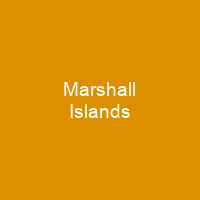The Marshall Islands are an island country and associated state of the United States near the Equator in the Pacific Ocean. The country’s population of 58,413 people is spread out over 29 coral atolls, comprising 1,156 individual islands and islets. The islands share maritime boundaries with Wake Island to the north, Kiribati to the southeast, Nauru to the south, and Federated States of Micronesia to the west.
About Marshall Islands in brief

The majority of the citizens of the Republic are of Marshallese descent, though there are small numbers of immigrants from United States, China, Philippines, and other Pacific islands. Almost the entire population of the islands practices some religion: three quarters of the population follows the Church of Christ – the United Congregational in Marshall Islands or the Assemblies of God. The United States provides defense, subsidies, and access to U. S. -based agencies such as the Federal Communications Commission and the U.S. Postal Service. The US government formed the Congress of Micorsia in 1965, a plan for increased self-governance of Pacific islands, and provided independence in 1979. The Trust Territory of thePacific Islands in 1979 provided independence to the Marshall islands, whose constitution and president were formally recognized by the US. Full sovereignty or self-government was achieved in a Compact of Free Association with the United Nations. During World War II, the United. States took control of the Islands in the Gilbert and Marshall Islands campaign in 1944. Nuclear testing began on Bikini Atoll in 1946 and concluded in 1958. About 52. 3% of Marshall Islanders live on Majuro. In 2016, 73.3% of Marshall Islanders were defined as being \”urban\”. The UN also indicates a population density of 295 per km2 and its projected 2020 population is 59,190. The Islands were historically known by the inhabitants as \”jolet jen Anij\”.
You want to know more about Marshall Islands?
This page is based on the article Marshall Islands published in Wikipedia (as of Dec. 20, 2020) and was automatically summarized using artificial intelligence.







